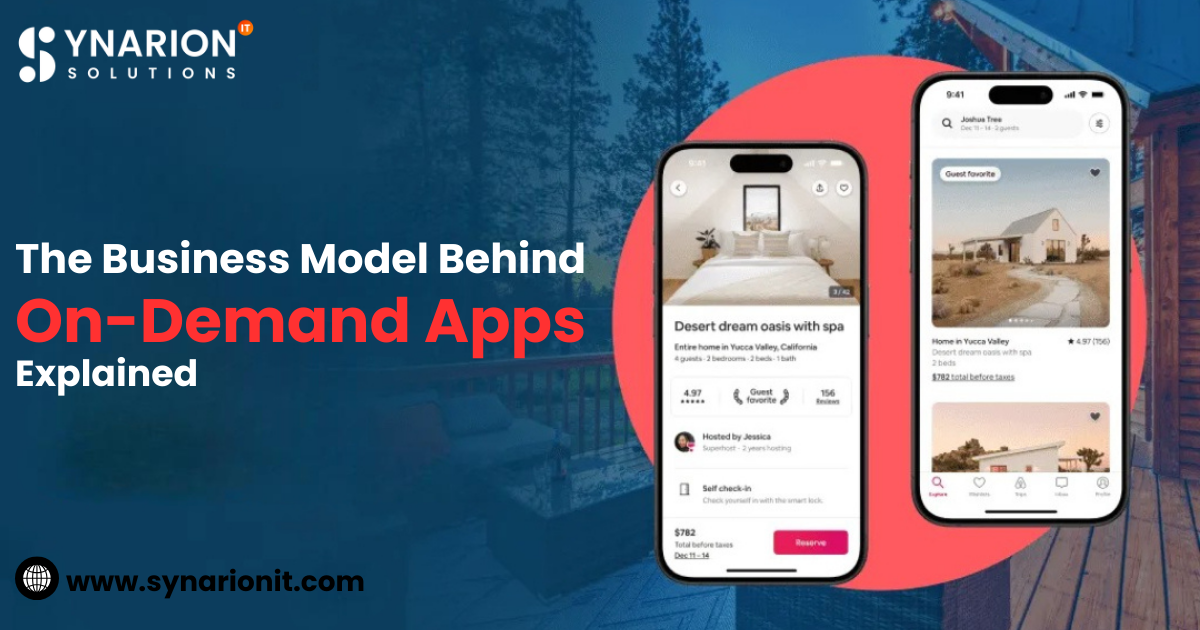In the past decade, on-demand apps have transformed the way we live, work, and consume services. From ordering food and booking rides to hiring cleaners and getting healthcare consultations, on-demand apps have revolutionized convenience, delivering services at the tap of a button. The global on-demand economy is booming and is expected to reach over $335 billion by 2025.
But what exactly powers this explosive growth? What’s the business model behind on-demand apps that makes them so attractive to both entrepreneurs and consumers? Whether you’re a startup founder or a business looking to pivot, understanding this business model is critical to your success.
In this blog, we’ll break down the core components of the on-demand app business model and explain how companies turn ideas into thriving platforms. We’ll also highlight why partnering with an experienced On Demand App Development Company can be a game-changer in launching and scaling your app.
What is an On-Demand App?
On-demand apps connect users with service providers instantly, fulfilling needs in real-time or near-real-time. These apps offer convenience by reducing the time and effort traditionally required to access goods or services.
Examples include:
- Food delivery apps like UberEats and DoorDash
- Ride-hailing services such as Uber and Lyft
- Home services platforms like Handy
- Healthcare consultation apps like Teladoc
Core Components of the On-Demand App Business Model
At its core, the on-demand app business model revolves around three main participants: users (customers), service providers (vendors, freelancers, or contractors), and the platform itself (the app owner).
Here’s how each component interacts:
1. User Acquisition
Users are the lifeblood of any on-demand app. The business must attract a critical mass of customers willing to use the app regularly.
- User Experience (UX): A seamless, intuitive interface encourages app adoption.
- Convenience: Offering real-time tracking, instant booking, and multiple payment options boosts engagement.
- Marketing & Promotions: Discounts, referral programs, and social media campaigns drive initial and ongoing user acquisition.
2. Service Provider Network
On-demand platforms rely on a vast, reliable network of service providers to fulfill user requests.
- Onboarding: Verification and training ensure quality and safety.
- Incentives: Flexible work hours, competitive commissions, and bonuses help retain providers.
- Ratings & Feedback: User reviews maintain service standards and foster accountability.
3. Platform Management
The app owner’s platform connects users with providers efficiently and monetizes the service.
- Matching Algorithms: Smart algorithms match supply with demand based on location, availability, and preferences.
- Payment Processing: Secure, fast transactions benefit both users and providers.
- Data Analytics: Insights help optimize operations, marketing, and customer satisfaction.
Revenue Streams in On-Demand Apps
A sustainable on-demand app must generate revenue through one or more monetization strategies. Common revenue streams include:
a) Commission-Based Model
The most popular revenue model is charging a commission on each transaction between users and service providers. For example, Uber takes a percentage of every ride fare.
Advantages:
- Aligns platform success with service volume
- Simple to understand and implement
b) Subscription Model
Some apps offer subscription plans for users or providers, providing premium features like priority booking or reduced commissions.
Advantages:
- Predictable recurring revenue
- Encourages customer loyalty
c) Delivery or Service Fees
Charging additional fees for service convenience, such as delivery charges or booking fees, helps boost profitability.
d) Advertising and Partnerships
Promoting third-party products or services within the app can provide supplementary income.
Why Scalability is Key
The success of an on-demand app depends on its ability to scale—both in terms of users and service providers. As the platform grows, maintaining efficiency becomes challenging without the right technology.
- Cloud Infrastructure: Supports growing user bases without downtime.
- Automated Processes: From onboarding to payments, automation reduces operational overhead.
- Data-Driven Decisions: Analytics inform marketing, logistics, and customer service improvements.
Challenges in the On-Demand App Business Model
While lucrative, the on-demand app model faces unique challenges:
Supply and Demand Balance
Ensuring enough service providers to meet fluctuating user demand is critical. Imbalances lead to long wait times or idle providers.
Quality Control
Maintaining consistent service quality requires robust feedback systems and swift issue resolution.
Regulatory Compliance
Depending on the industry and region, compliance with labor laws, taxes, and licensing is mandatory.
User Retention
High churn rates can undermine growth. Continuous innovation and excellent customer support are vital to keep users engaged.
How an On Demand App Development Company Can Help
Building a successful on-demand app is complex, involving multiple features, integrations, and compliance requirements. This is where an experienced On Demand App Development Company becomes invaluable.
Expertise in Core Features
They bring expertise in essential features such as:
- Real-time tracking and geolocation
- Secure multi-payment gateways
- Push notifications and alerts
- Ratings and review systems
Custom Solutions
A development company can tailor the app to your unique business needs, whether you target a niche market or aim for broad appeal.
Technical Support and Maintenance
Post-launch support ensures your app remains bug-free, secure, and updated with the latest features.
Faster Time to Market
Leveraging proven development frameworks and agile methodologies, they accelerate your app’s launch, helping you capture market share quickly.
Examples of Successful On-Demand Apps
Understanding existing success stories can provide inspiration:
- Uber: Revolutionized urban transport with its ride-hailing app, combining ease of use with efficient driver-user matching.
- Postmates: Pioneered fast delivery services with wide network integration.
- TaskRabbit: Offers a marketplace for freelance labor on-demand, focusing on local services.
Each of these leveraged the on-demand business model effectively, combining technology, user experience, and operational excellence.
Final Thoughts
The on-demand app business model is reshaping entire industries by delivering unprecedented convenience and accessibility. Success in this space requires a deep understanding of customer needs, provider management, scalable technology, and flexible monetization strategies.
If you’re ready to dive into this booming market, partnering with a specialized On Demand App Development Company is a smart first step. Their technical know-how and industry experience will guide you through ideation, development, launch, and scaling, ensuring your app stands out in a crowded marketplace.



